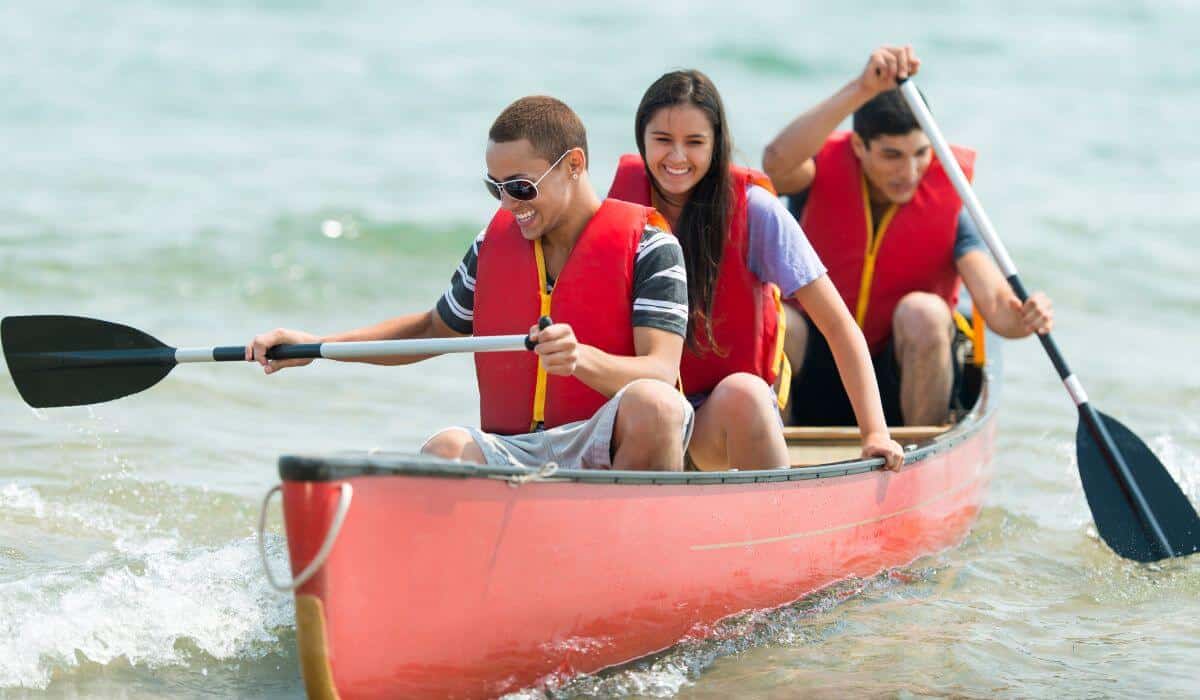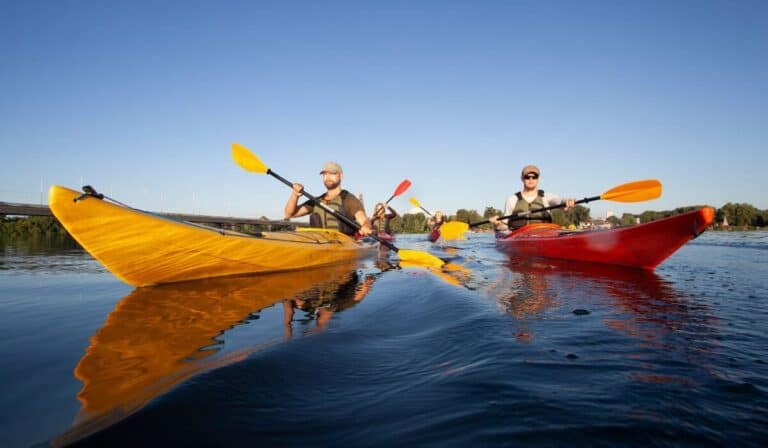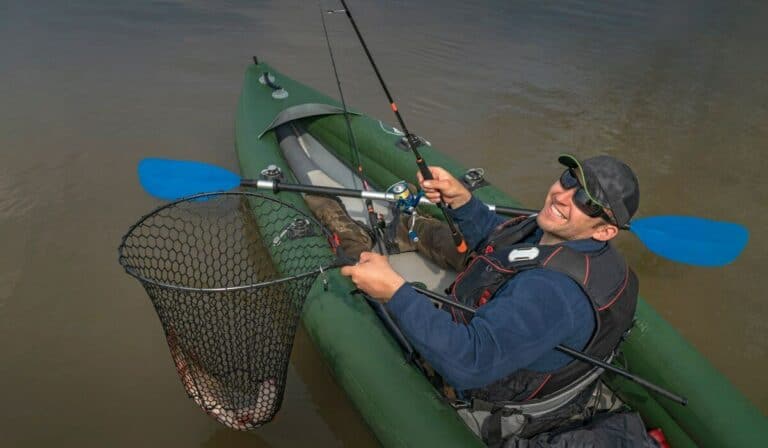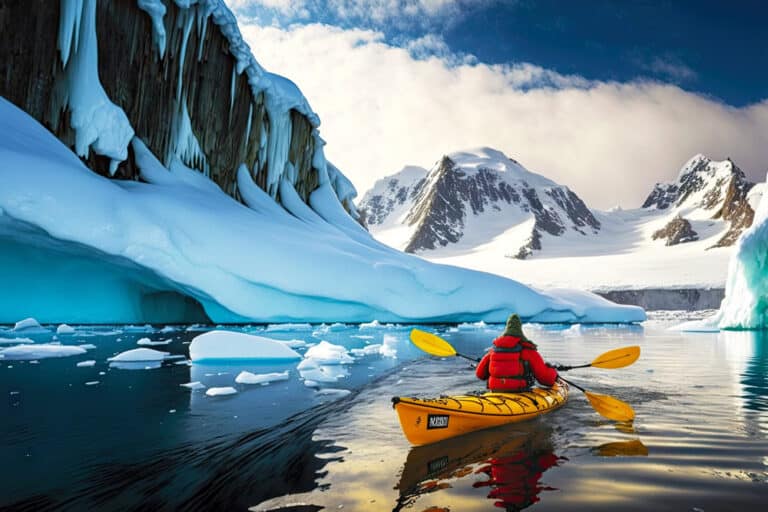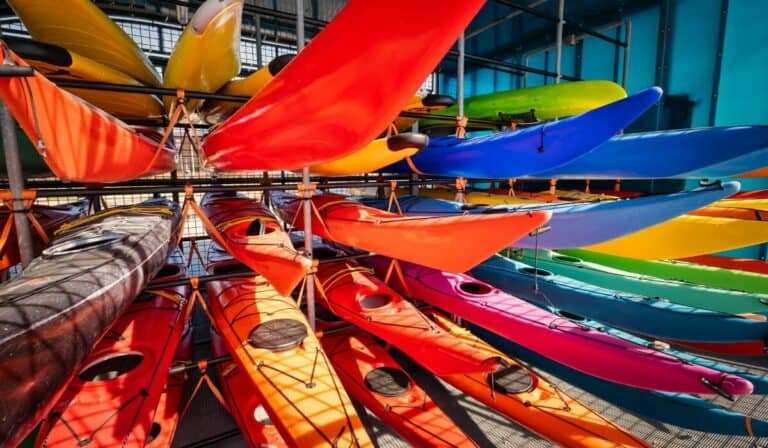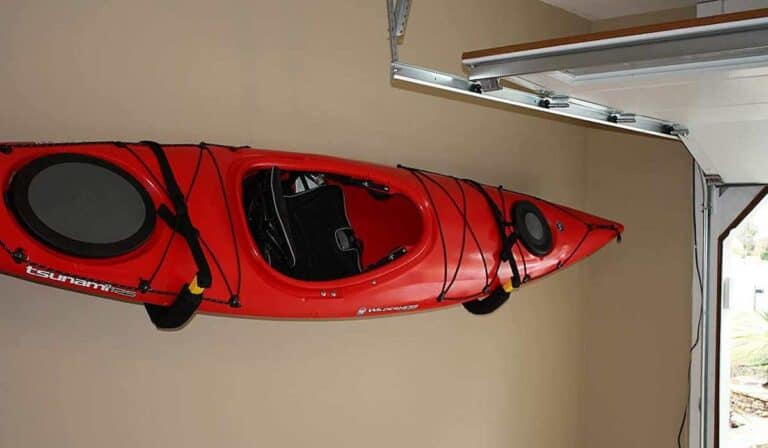Kayaking Vs Canoeing: Two Great Ways to Explore the Outdoors
When it comes to exploring the great outdoors and experiencing new adventures on the water, the age-old debate of “Kayaking vs Canoeing” often arises. Both activities offer unique experiences and challenges that cater to different preferences and skill levels. In this comprehensive blog post, we will delve into the advantages and disadvantages of each activity, providing you with valuable insights to make an informed decision.
We’ll discuss various aspects such as gear requirements, paddling techniques, types of kayaks and canoes available in the market, and storage space considerations for your camping gear during trips, among other essential factors. Ultimately, the decision between kayaking or canoeing is up to you; however, our thorough examination can assist in determining which one better meets your requirements.
So sit back comfortably as we embark on this exciting journey through “Kayaking vs Canoeing,” comparing these two popular water sports while highlighting their distinct features and benefits.
Table of Contents
Kayaking: Advantages and Disadvantages

Kayaking is a great way to explore the outdoors and experience nature in its full glory. It’s also an activity that can be enjoyed by people of all ages and skill levels. Before embarking on a kayaking adventure, it is important to weigh the pros and cons of the activity.
Kayaking Advantages
One of the biggest advantages of kayaking is its maneuverability. Kayaks are incredibly easy to turn and can even spin around in circles if needed, making them ideal for exploring tight spaces or navigating tricky waters with ease. This makes them especially well-suited for whitewater rapids or narrow rivers where other boats might not fit as easily.
For those looking to save money and still enjoy the water, kayaking is an ideal choice as it tends to be much less expensive than other boats or canoes. Plus, most kayaks are lightweight enough that they can be carried from place to place without too much effort – perfect if you’re looking for something more portable than other types of boats.
Kayaking, while offering plenty of maneuverability and being a budget-friendly option, may not be suitable for everyone due to its lack of speed compared to canoes. Additionally, it requires physical strength and stamina that might prove too challenging depending on one’s fitness level or age group; unless you opt for an electric model, paddling is necessary which can be quite the workout.
Disadvantages of Kayaks vs Canoes
Storage space can be a limiting factor when it comes to kayaking; although many models come with compartments for stowing away your supplies, these tend to fill up fast and eat into the legroom inside the boat. For those looking to bring along extra gear, this could prove problematic – so bear that in mind before setting off.
Kayaking offers an unparalleled opportunity to investigate nature and is a pleasant pastime for all ages. However, it does require more skill than canoeing in order to be done safely. Canoeing possesses its own positives and negatives that should be weighed before choosing which type of vessel is ideal for you.
The Key Takeaway: Although kayaking is a cost-effective way to enjoy the outdoors with great maneuverability, it may not be suitable for all due to its low speed and physical demands. Nevertheless, with some careful planning, it can still provide hours of fun.
Canoeing: Advantages and Disadvantages

Canoeing offers a unique way to explore the outdoors and experience nature. Canoeing offers numerous perks, such as steadiness, portability, cost-effectiveness and ease of operation. Canoes are also relatively easy to store when not in use.
Advantages of Canoes
Canoeing offers the benefit of stability, unlike other watercraft that need balance and expertise to remain upright. Unlike kayaks or other watercraft that require balance and skill to stay upright, canoes have a wide base that makes them more stable on the water. This means they are ideal for beginners who may not be as experienced with navigating waterways safely.
Canoes are also incredibly portable due to their lightweight design and size which make them easy to transport from one location to another via car or truck bed without needing additional equipment like trailers or dollies. They’re also affordable compared to other boats such as motorboats or sailboats which require costly fuel costs and maintenance fees over time. When compared to kayaks, canoes usually require at least 2 people to transport them to the water.
In addition, canoes are easier for inexperienced paddlers than kayaks since you don’t need any special skills or techniques in order to paddle effectively; all you need is an oar. Lastly, because they’re so small when deflated (or even folded up), they’re much easier to store than larger boats when not in use – making them perfect for those who don’t have a lot of space at home but still want access to watersports activities whenever possible.
Having the correct knowledge of each type’s advantages and disadvantages can help you determine which is most suitable for your outdoor excursion. Moving on to Kayaking vs Canoeing: Which is Better?, let’s explore the differences between these two popular water sports.
The Key Takeaway: Canoeing can be an excellent entry point for novice outdoor adventurers, as it offers a stable and portable experience with no need to learn any special techniques. For those with limited storage, canoeing is a great way to access watersports activities without breaking the bank.
Kayaking vs Canoeing: Which is Better?

Canoeing and kayaking are two widely-enjoyed aquatic activities that provide a range of recreational opportunities. Both involve paddling through the water, but they have different advantages and disadvantages. To determine which is better for you, it’s important to consider your individual needs and preferences.
Kayaks tend to be swifter than canoes as their shape enables them to slice through the liquid more effectively. Kayaks also offer greater maneuverability due to their shorter length; this makes them ideal for navigating narrow rivers or tight turns in the water. On the other hand, canoes are generally slower but wider than kayaks; this gives them stability on choppy waters or open lakes.
For those looking for an adrenaline rush, kayaking may be preferable since its design allows users to navigate rapids with ease while still providing enough stability and control over direction. Canoeing is usually best suited for leisurely trips on calm waters such as ponds or slow-moving rivers where there aren’t any obstacles or fast currents present.
When it comes to storage capacity, canoes win out as they typically have more room for gear compared with a kayak of similar size – so if you’re planning an extended trip then canoeing might be your best bet. However, if space isn’t an issue then either option should work fine since both types of vessels provide ample seating room (upwards of three people).
Ultimately, both options provide hours upon hours of fun whether alone or with friends and family members, so why not give each one a try? Depending on what type of vessel you choose (inflatable vs hardshell), prices range from relatively affordable to luxury territory, so it depends largely on personal preference and budget constraints.
Depending on individual preference, kayaking, and canoeing can both be excellent ways to explore the outdoors. Discussing the equipment necessary for a secure and pleasurable kayaking experience is the next issue to consider.
The Key Takeaway: Considering individual requirements is key when opting for either kayaking or canoeing, as each has its own perks. Kayaks tend to be faster and more maneuverable while canoes are better suited for leisurely trips with more storage capacity. Both provide great opportunities for fun on the water.
Kayaking Gear: What You Need to Know

Kayaking is an excellent way to savor nature and stay active. Before setting off, ensure you have all the necessary gear for kayaking. Here’s what you need to know about kayaking equipment:
A paddle is a must-have for any kayaking excursion, and its adjustable length should accommodate the varying heights of your group. You want something that is lightweight but strong enough for long trips on the water. Look for paddles with adjustable lengths so they can fit different-sized people in your group. Make sure your paddle blades are wide enough for good power strokes when paddling against currents or waves.
Life Jackets:
A life jacket is one of the most important pieces of safety equipment when it comes to kayaking, as it will keep you afloat if anything happens while out on the water. Choose a life jacket that fits snugly and won’t ride up over your chin or face while paddling. Choose a jacket crafted from resilient fabrics such as nylon or neoprene, so it can withstand repeated use in various conditions.
Spray Skirts:
Spray skirts help protect your lower body from getting wet while paddling in rough waters or high winds, which can cause waves to splash into your boat and soak everything inside. Choose a spray skirt made from a waterproof material like neoprene, and make sure it fits snugly around both yourself and your boat’s cockpit rim without any gaps where water could enter through them during use.
Dry Bags:
Dry bags are great for keeping electronics safe from splashes or rain showers while out on the lake or river bank camping overnight – just remember not to put too much weight inside them. They come in various sizes depending on how much storage space you need, so choose one accordingly based on what items will be going inside (i-pads/phones/cameras, etc).
Sun protection is key when spending time outdoors, especially near bodies of water since their reflection amplifies UV rays even more than usual. Pack hats, sunglasses, sunblock lotion (SPF 30+), rash guards/swim shirts with UPF 50+, and other protective clothing items such as long-sleeve shirts and pants with fabric technology designed specifically for outdoor activities like fishing and kayaking alike.
Kayaking can be an exhilarating and satisfying pursuit, yet it’s imperative to have the correct apparatus for a secure and delightful experience. It’s essential to know what equipment is necessary for a successful kayaking trip. With this knowledge, you can now move on to understanding canoeing gear: what equipment do you need for your next paddling adventure?
Canoeing Gear: What You Need to Know
Canoeing is an incredibly popular outdoor activity, but before you hit the water, it’s important to make sure you have all the right gear. To start off, you’ll need a canoe and paddles. Selecting a canoe is essential; there are various shapes and sizes, so pick one that suits your purpose. For example, if you’re planning on taking a long trip downriver then a longer boat may be more suitable than if you’re just looking for some recreational paddling on a lake or pond.
When selecting a paddle, one must consider whether to go with the single-blade for maneuverability or the double-blade for more power. Single-blade paddles are great for maneuverability while double-blades provide more power when pushing through strong currents or windy conditions. It’s also important to consider weight when choosing your paddle; lighter ones will be easier on your arms during extended trips but heavier ones can give you more control over steering in rough waters.
Safety is key when out on the water so don’t forget about life jackets. Look for vests that fit comfortably and snugly around your body without restricting movement too much as this could limit how well they protect you in case of an emergency situation. Also, keep an eye out for any additional safety features such as reflective tape or whistle attachments which can help alert others should something happen while out on the water.
Finally, other accessories like dry bags or coolers can make your time spent canoeing even better by keeping items safe from moisture and providing easy access to snacks throughout the day. Be sure to look into straps designed specifically for securing these items onto boats before hitting up those rapids though – nothing worse than having them go flying overboard mid-ride. With these essentials taken care of, all that’s left is to find yourself some clear blue waters and set off with confidence knowing that no matter what happens at least now you’re prepared.
The Key Takeaway: Ensuring the right equipment is acquired prior to setting off on a canoeing excursion is paramount for an enjoyable experience – from boats and paddles to life vests and extra gear. With these essentials taken care of, now all that’s left is “casting off” with confidence knowing you’re prepared for whatever comes your way.
FAQs Ab Kayaking vs Canoeing
Is kayaking or canoeing better?
It is impossible to say which activity, kayaking or canoeing, is superior as it comes down to personal preference and individual requirements. Kayaks tend to be more maneuverable than canoes, which makes them ideal for tight spaces such as rivers with many turns and obstacles.
Canoes, with their wider structure, tend to be steadier than kayaks and are a great pick for those seeking an easier time remaining upright in turbulent waters. Both activities offer unique advantages that make each suitable for different types of water adventures; therefore it comes down to what type of experience you’re looking for when deciding between the two.
What is the difference between kayaking and canoeing?
Kayaking and canoeing are both forms of watercraft used for recreation. A kayak is an enclosed boat with a double-bladed paddle, while canoes use single-bladed paddles in open boats.
Kayaks provide more stability in choppy waters due to their design, but canoes offer greater maneuverability as they have less drag on the water. Both vessels require skill and practice to use properly; however, some people prefer one over the other based on personal preference or what activity they plan to do with it.
Why choose a canoe over a kayak?
Canoes offer more stability than kayaks due to their wider, flat bottom. Canoes are easier to enter and exit as they sit lower in the water and have a higher freeboard. They also provide more storage space for gear due to their larger size.
Additionally, canoes allow two people or even three if needed to paddle together, whereas kayaks typically only accommodate one person at a time. Lastly, canoes are generally less expensive than kayaks of comparable quality and durability.
What are the disadvantages of canoeing?
Though canoeing can be a pleasant way to experience nature, its slower speed and more demanding physicality may limit the distance one is able to cover. Canoes are not speedy or agile compared to motorboats, making it tough to cover extensive areas in a limited time.
Additionally, they require more physical effort and skill than other types of watercrafts. Lastly, canoeing is only possible during certain times of the year due to weather conditions and water levels; if you plan on going out when the conditions aren’t ideal then you could find yourself stranded without any help.
The WINNER?
There is no clear victor between kayaking and canoeing exists; it’s a matter of personal needs. Both activities offer a unique experience and the choice ultimately depends on personal preference.
Kayaks are more maneuverable in tight spaces while canoes provide greater stability and capacity for gear or multiple passengers. Canoes are more stable, have more storage room and are better suited for trips including 2 to 3 people.
Be sure to do your research when selecting equipment as both require specific gear for optimal performance. No matter which you choose, be prepared for an unforgettable outdoor adventure.

